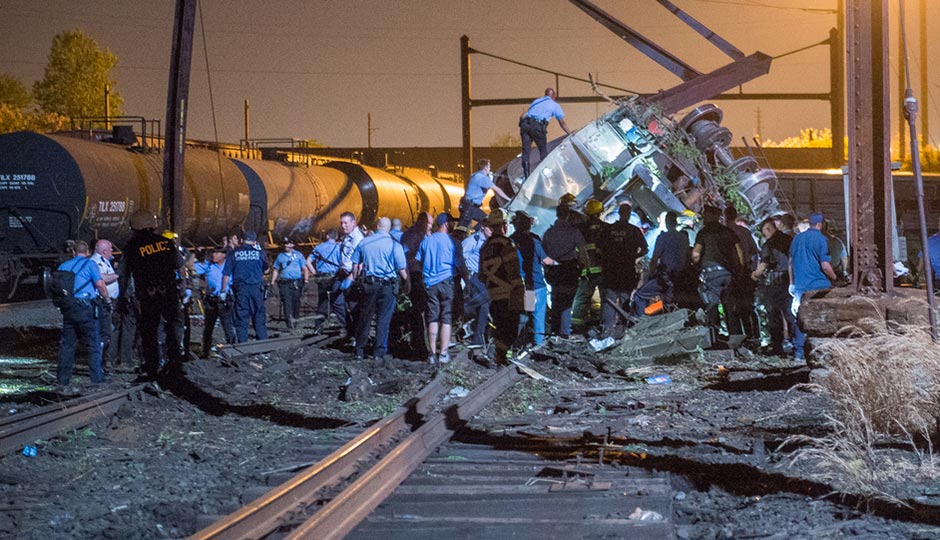Did the Derailed Amtrak Train Nearly Collide With an Oil-Filled Freight Car?

Emergency responders work on an overturned Amtrak car close to tanker cars on May 12, 2015. Photograph by Bryan Woolston
There’s a terrifying sight in the background of some photos from Tuesday night’s horrific Amtrak derailment: a series of black rail cars, the color and shape of Tootsie Rolls.
They look like standard rail tanker cars, and while we don’t yet know for certain what was in them, it probably wasn’t corn syrup. In fact, there’s a good chance those tankers were filled with crude oil.
Between 45 and 80 oil trains rumble through Philadelphia each week; some of them are a mile long or more. They’re hauling crude — a lot of it from North Dakota — that’s destined either for the refinery in South Philadelphia or terminals and refining operations along the Jersey side of the Delaware River.
One of the big oil train routes is the freight line that runs parallel to Amtrak’s track on the northeastern corridor. Trains from points west travel that track to reach the South Jersey crude consumers.
Judging from the photos, the out-of-control train came uncomfortably close to plowing into one or more of those tanker cars. It’s frightening to imagine how much worse this tragedy could have been. One witness told CNN the train missed a tanker “by maybe 50 yards.”

By the morning of May 13th, the tankers appeared to have been moved. Associated Press photo
In some images from the scene, it looks as though the train got even closer to the tanker than that.
https://twitter.com/RexBainbridge/status/598606625881137153
Conrail — which owns the rail yard where the tanker cars were parked — won’t say what was in them.
“We consider our customer information proprietary and confidential,” said Conrail spokesman John Enright, who said the focus should be on the families of the victims and the incident itself, “which is of course an Amtrak-related incident, not a Conrail one.”
“Your inquiry goes to the question of what might have happened, which we don’t really feel we should respond to, being speculative,” Enright said.
(Update, 11:20 p.m.: An Inquirer story posted earlier this evening claims a member of the NTSB was told — though it doesn’t specify by whom — that the cars were empty at the time of the crash.)
When oil trains catch fire, the results can be cataclysmic. Two years ago, a runaway oil train in the Québec town of Lac-Mégantic plowed into a nightclub and killed 47 people. There have been plenty of other oil train fires as well, though most of those have been in sparsely populated areas.
A large-scale oil train fire in Philadelphia would be a fiasco. Federal officials recommend evacuating all people within a half-mile of an oil train fire — that’s how destructive they can be. Given the extent and location of the freight rail lines in Philadelphia — they cross Drexel and Penn, cut through the heart of western South Philadelphia, and arc across North Philly to Port Richmond — such an evacuation would be a huge undertaking. City officials say they are prepared.
While no oil trains have caught fire in Philadelphia, they have derailed on at least two occasions. In January 2014, a train with tanker cars jumped the track while crossing the Schuylkill River — the cars dangled above the water for days until railroad crews could right them. A year later, 11 tank cars derailed in a CSX rail yard near the sports complex. Nobody was hurt in either incident, and not a drop of oil was spilled. But the mishaps highlighted the fact that Philadelphia has some of the highest big-city oil-train traffic volume in the nation.
One of the big reasons why is the Philadelphia Energy Solutions refinery in South Philadelphia. The facility is the single largest consumer of crude from the Bakken oil fields of North Dakota in the nation, and the vast majority of the crude it converts to petroleum products now travels by rail.
In a Q&A with Philadelphia magazine earlier this year, PES CEO Phil Rinaldi said crude-by-rail is “here to stay.”
And perhaps it is. But the mass movement of crude oil by rail is a brand-new development, one driven by the rising costs of importing crude from sources like Africa (which was the dominant supplier of the South Philly refinery for decades) and by fracking technology that’s made oil extraction viable in deposits across America and Canada that are far away from big pipelines.
Indeed, PES’s entire business model right now rests on moving crude by train. Without that option, in all likelihood the South Philly refinery would be closed, and a major economic anchor of the region would be lost.
Rinaldi downplayed the risks oil trains present in our interview.
“What are the inherent properties of moving crude oil? It’s crude oil. It does burn. It can burn. That’s why we use it. But we’ve been transporting more volatile materials for a long time,” Rinaldi said.
There’s little doubt that products far more toxic and dangerous than crude oil are transported by train. But those chemicals are often stored in pressurized cars that are designed to remain intact even in accidents. The tanker cars carrying crude often aren’t, although the federal government is trying to phase out use of older tank cars for crude transportation.
The city’s already had two narrow misses with oil train disasters. We may ultimately find out that Tuesday’s derailment — lethal as it was — represented a third.